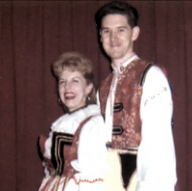
|
Folk Dance Federation of California, South, Inc.
|

|
CLICK IMAGE TO ENLARGE
"The tango," said George Bernard Shaw in 1930, "is the only modern ballroom dance that deserves to be called a dance." Despite its folk background of Spain, Cuba, and Argentina, the tango is not a "folk dance" but strictly a ballroom dance form, like the Viennese Waltz – the tango and the waltz being the two dances that have endured through the years.
The origin of the Argentine Tango can probably be traced, in the last analysis, to the Spanish Gypsies, who performed a flamenco dance called a "tango" as a solo number by a woman dancer, never with a partner, and using much heel-work and many rhythm changes. Spanish dancers brought the dance to Argentina as entertainers in the ill-famed waterfront dance halls of Buenos Aires, where the solo number became in time a duet, then a couple dance, first known as "baile con corte" (the dance with a stop). Very full skirts were worn by the women, and the men dressed in a Gaucho costume consisting of high-top boots with spurs. Probably the attempt in these cumbersome clothes accounts for some of the movements which afterward became identified with the Tango. Lifting the heel slightly on the slow steps, for example, may have originated from the Gaucho clearing his spur of entanglement before he stepped.
The gallants of Buenos Aires saw this dance and introduced it to their own cafés, also of doubtful respectability, but made several changes in both the music and the steps, and combined it with the Habanera, a popular dance from Cuba. It was still not for many years, however, that it was considered a proper, or even a "nice," dance.
Instead, however, of being the "height of offensiveness" as one writer put it, the dance, sponsored by Vernon and Irene Castle, and other exhibition teams, was an immediate hit. In "The Four Horsemen of the Apocalypse" in 1921 and his later movies, Rudolph Valentino and the Argentine Tango were carried in a great wave of popularity.
This early Tango was much different from the Tango of today. It has been modified by the French into a continental Tango, then re-modified by the the recent interests in South American music. As a result, the dance has been simplified from its "over 200 figures," requiring exact footwork and an expert dancer, to a dance capable of being enjoyed by anyone on the ballroom floor.
The Tango is written in 2/4 time, counting two beats for a slow step, one for a quick step, and taking two measures to complete a Slow-Slow-quick-quick-Slow basic step. The upper body is held straight, but relaxed, and the weight positioned over the standing foot when a step is taken. When moving backward, the legs swing back from the hips with the toes meeting the floor first, immediately followed by the ball of the foot and the heel. The man must always lead his partner; the Tango is essentially a masculine dance, and movements and changes of direction must be indicated by the man. Holding the slow steps until the last possible moment before moving the foot creates a "dragging" or "stealthy" effect which, combined with the smooth (no bounce), almost "slinking" steps, does more than just about anything to ensure your Tango looking like a Tango.
Used with permission of the authors.
Reprinted from the 1964 University of the Pacific (Stockton) Folk Dance Camp syllabus.